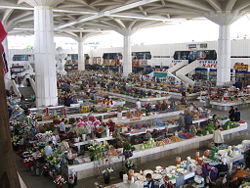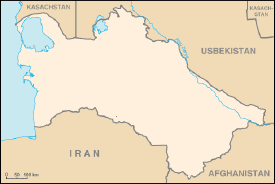Ashgabat
| Ashgabad Aşgabad |
|
| Coordinates: 37°58′N 58°20′E | |
|---|---|
| Country | |
| Province | Ahal Province |
| founded | 1818 |
| Population (2001) | |
| - Total | 695,300 |
Ashgabat (Aşgabat in Turkmen) is the capital and largest city of Turkmenistan, a country in Central Asia, and is situated between the Kara Kum desert and the Kopet Dag mountain range, about 19 miles (30 kilometers) from the Iranian frontier. It is 250km from the second largest city in Iran, Mashhad.
Geography
The name "Ashgabat" is believed to derive either from the Persian Ashk-ābād meaning "the City of Arsaces", or a loose translation of the Persian عشق (eshq meaning "love") and آباد (ābād meaning "cultivated place" or "city"), "the city of love.".
The Kopet-Dag mountain range is about 25km to the south, and Ashgabat's northern boundary touches the Kara-Kum desert. Because of this location, Ashgabat has an arid climate with hot and dry summers and mild and short winters. Summer temperatures can easily reach 104°F (40°C) for long periods of time. June through August are hot, with night temperatures normally not falling lower than 86°F (30°C). Winter normally starts in December; snow is rare and there can be a lot of rain. Normally, winter temperatures are 50-60°F (10-15°C), and rarely can go as low as -10°C (14°F) in January. The lowest temperature was recorded in January 1969, -18°F (-28°C).
The desert city suffered a chronic water shortage until the Karakum Canal, the largest irrigation and water supply canal in the world, from the Amu-Darya River across the Karakum Desert, reached the city in 1962.
A magnitude 7.3 earthquake caused extreme damage in Ashgabat and nearby villages, on October 5, 1948. Up to 110,000 died in the event in which almost all brick buildings collapsed, concrete structures were heavily damaged and freight trains were derailed.
Size – land area, size comparison
Districts
History
Ashgabat is a relatively young city, growing out of a village of the same name established in 1818. It is not far from the site of Nisa, the ancient capital of the Parthians and the ruins of the Silk Road city of Konjikala, which had been destroyed either by an earthquake in the first decade BC, or by the Mongols in the 13th century.
It remained a part of Persia until 1884. In 1869, Russian soldiers built a fortress on a hill near the village, and this added security soon attracted merchants and craftsmen to the area. Tsarist Russia annexed the region in 1884 from Persia under he terms of Akhal Treaty, and chose to develop the town as a regional center due to its proximity to the border of British-influenced Persia. It was regarded as a pleasant town with European style buildings, shops and hotels.
In 1908, the first Bahá'í House of Worship was built in Ashgabat. After being taken by Soviet officials, it was seriously damaged as a result of earthquake in 1948 and was demolished by the Soviet authorities in 1963. [1] [2]
Soviet rule was established, lost and then regained in 1917, and the city was renamed Poltoratsk after a local revolutionary. The name "Ashgabat" was restored in 1927 when the Communist Party was properly established in Turkmenistan, though it was usually known by the Russian form Ashkhabad. From this period onward the city experienced rapid growth and industrialisation, although this was severely disrupted by a major earthquake on October 6 1948. An estimated 7.3 on the Richter scale, the earthquake killed over 110,000 (2/3 the population of the city), although the official number announced by Soviet news was only 14,000.
Government
Economy

Overview – Any specialization: For instance, is a manufactured product is associated with particular cities a. Milwaukee—cheese and beer b. Los Angeles—entertainment industry c. Sheffield—coal d. top 20 cities in the U.S. are highly specialized
Per capita GDP, rank Financial and business services sector Tourism Manufacturing
Transport: Road, rail, air, sea
Ashgabat is primarily a government and administrative center. The principal industries are cotton textiles and metal working. It is a major stop on the Trans-Caspian railway.
The city is served by Ashgabat Airport, the only international airport in Turkmenistan. It is located approximately six miles (10km) northwest of the city. The airport, with its air traffic control tower and a 12,000 foot-long precision-approach runway (12L-30R), opened in 1994 and was named after the country's first president, Saparmyrat Niyazov.
Demographics
It had a population of 695,300 in 2001.
Ashgabat has a primarily Turkmen population, with minorities of ethnic Russians, Armenians, and Azeris. Race/ethnicity - historical background of ethnic groups
Language
Religion
Colleges and universities
The Ashgabat International School is an international school in Ashgabat, Turkmenistan. It is a private, non-profit day school which offers an educational program from a 3 to 4 year old program through high school for students of all nationalities. High school students may take courses by distance learning through the University of Nebraska High School Correspondence Program.
Notable buildings
Museums include the Turkmen Fine Arts Museum, noted for its impressive collection of woven carpets, and a Turkmen history museum Ashgabat National Museum of History which has artifacts dating back to the Parthian and Persian civilisations. The Academy of Sciences of Turkmenistan is an important institute of higher learning. Large mosques include the Azadi Mosque (which resembles the Blue Mosque in Istanbul), the Khezrety Omar Mosque, and the futuristic Iranian Mosque. Ashgabat is also home to the Arch of Neutrality, which is a large tripod on which there is a golden statue of former President Saparmurat Niyazov (also known and generally referred to as Turkmenbashi, or leader of the Turkmens). This statue rotates in order to always face the sun during daylight hours. It is said to be made of pure gold.
- Türkmenbaşı Palace presidential headquarters
- Rukhiyet Palace
- IndependenceMonumentAshgabat.jpg
Independence and Peace Monument
- PresidentialPalaceAshgabat.jpg
Türkmenbaşı Palace
- ExhibitionCenterAshgabat.jpg
Ashgabat Exhibition Center
- AkBugdayMuseum.jpg
Ak Bugday (White Wheat) Museum, settlement of Anau, outskirts of Ashgabat
- RukhiyetPalace.jpg
Ruhiyet Palace
- TheatherAshgabat.jpg
Musical Drama Theater
- AshgabatAssembly.jpg
Assembly of Ashgabat
- Ashgabat SPOT 1090.jpg
Ashgabat seen from SPOT satellite
External links
Credits
New World Encyclopedia writers and editors rewrote and completed the Wikipedia article in accordance with New World Encyclopedia standards. This article abides by terms of the Creative Commons CC-by-sa 3.0 License (CC-by-sa), which may be used and disseminated with proper attribution. Credit is due under the terms of this license that can reference both the New World Encyclopedia contributors and the selfless volunteer contributors of the Wikimedia Foundation. To cite this article click here for a list of acceptable citing formats.The history of earlier contributions by wikipedians is accessible to researchers here:
The history of this article since it was imported to New World Encyclopedia:
Note: Some restrictions may apply to use of individual images which are separately licensed.

